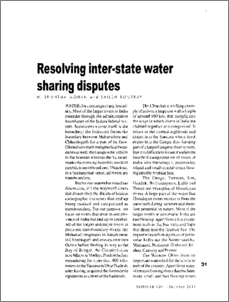Mohan, N Shantha and Routray, Sailen
(2011)
Resolving inter-state water sharing disputes.
Seminar (626).
pp. 31-35.
![[img]](http://eprints.nias.res.in/style/images/fileicons/application_pdf.png)  Preview |
|
PDF
Resolving_interstate_water_sharing_disputes.pdf
- Published Version
Download (297kB)
|
| Abstract: |
WATER does not respect any boundary. Most of the larger rivers in India meander through the administrative boundaries of the Indian federal system. Sometimes a river itself is the boundary: the Indravati forms the boundary between Maharashtra and Chhattisgarh for a part of its flow. Often rivers mark metaphorical boundaries as well: the Ganga is the vehicle to the heavens whereas the Vaitarani marks the crossing from this world of mortals to an infernal one. Therefore, in a fundamental sense, all rivers are transboundary.
But for our somewhat mundane discussion, it’s the wayward rivers that do not obey the diktats of human cartographic exercises that end up being marked and categorized as transboundary. For our purpose, we focus on rivers that arise in one province of India but end up in another. All of the longer and major rivers in India are transboundary rivers: the Mahanadi originates in Amarkantak in Chhattisgarh and crosses over into Orissa before finding its way to the Bay of Bengal; the Chambal rises near Mhow in Madhya Pradesh before meandering for more than 900 kilometres to the Yamuna in Uttar Pradesh, after having acquired the formidable reputation as a river of the badlands. |
| Item Type: |
Journal Paper
|
| Subjects: |
Doctoral Programme > PhD Scholar Publications
Programmes > Water Programme |
| Divisions: |
Schools > Social Sciences |
| Date Deposited: |
14 Nov 2011 04:16 |
| Last Modified: |
04 Jun 2021 12:41 |
| Official URL: |
http://www.india-seminar.com/semframe.html |
| Related URLs: |
|
| Funders: |
UNSPECIFIED |
| Projects: |
UNSPECIFIED |
| DOI: |
|
| URI: |
http://eprints.nias.res.in/id/eprint/239 |
Actions (login required)
 |
View Item |


